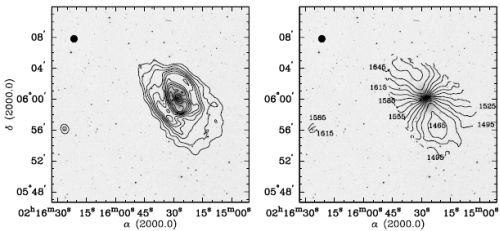The large asymmetric HI envelope of CIG 96 (2005)
Scientific Results
- Positions for CIG galaxies
- Redshift and distances
- Morphologies
- Isolation
- A catalogue of neighbours around isolated galaxies based on POSS I & II images
- Quantification of isolation based on POSS I & II images
- Revision of isolation criteria using the SDSS
- Effects of the environment on galaxies in the..
- Catalogues of isolated galaxies, isolated pairs, and isolated triplets..
- Star formation
- Optical specialization
- Radio continuum properties
- Atomic gas
- Isolated Galaxies
- Environment and faint features of CIG 96: deep optical and HI observations (2018)
- Atomic gas scaling relations (2018)
- A ∼12 kpc HI extension and other HI asymmetries in the isolated galaxy CIG 340 (2014)
- HI asymmetry in the isolated galaxy CIG 85 (2012)
- HI asymmetries in the isolated galaxy CIG 292 (2011)
- Asymmetries in isolated galaxies (2011)
- The large asymmetric HI envelope of CIG 96 (2005)
- Compact groups
- Studies of complementary samples
- Isolated Galaxies
- Molecular gas
- Nuclear activity
The large asymmetric HI envelope of CIG 96
We have also observed 12 galaxies at the VLA, selected to have asymmetric HI profiles in order to understand the origin of the asymmetries in isolated galaxies. One of these galaxies (CIG 96 = NGC 864) is particularly interesting due to the large level of asymmetry in its HI distribution.
Fig. 1 HI column density distribution (left) and velocity field (right) of NGC 864 and its companion, superimposed on the optical POSS2 red band image. The contour levels are: 5, 12, 24, 37, 49, 61, 73, 86, 98, 110 and 122 x 1020 cm-2. The velocity contours go from 1465 to 1660 km s-1 in intervals of 15 km s-1, and are labeled each 30 km s-1. The beam size of 49″.8 x 46″.2 is shown in the upper left of all panels.
The asymmetry in the HI profile is associated with a strong kinematical perturbation in the gaseous envelope of the galaxy, where at one side the decay of the rotation curve is faster than Keplerian. We detect a small (M(HI) = 5×106Mo) galaxy with a faint optical counterpart at ~80 kpc projected distance from NGC 864. This galaxy is probably not massive enough to have caused the perturbations in NGC 864. We discuss alternatives, such as the accretion of a gaseous companion at a radial velocity lower than the maximum. All these results have been presented in the PhD of D. Espada.
Espada, 2006 PhD Espada et al. 2005
Espada et al. 2005
